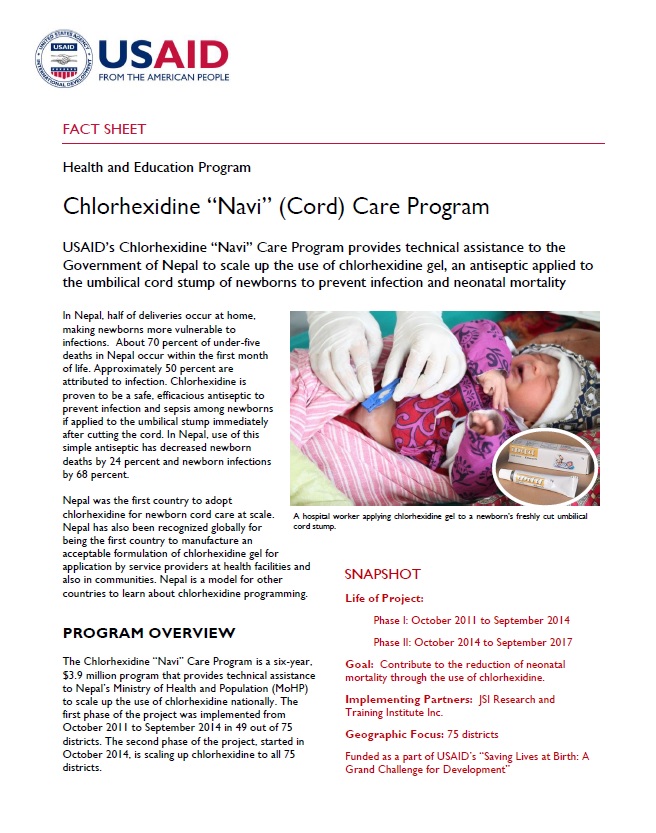Speeches Shim
Chlorhexidine “Navi” (Cord) Care Program
USAID’s Chlorhexidine “Navi” Care Program provides technical assistance to the Government of Nepal to scale up the use of chlorhexidine gel, an antiseptic applied to the umbilical cord stump of newborns to prevent infection and neonatal mortality.
Chlorhexidine “Navi” (Cord) Care Program ![]() (pdf - 269k)
(pdf - 269k)
In Nepal, half of deliveries occur at home, making newborns more vulnerable to infections. About 70 percent of under-five deaths in Nepal occur within the first month of life. Approximately 50 percent are attributed to infection. Chlorhexidine is proven to be a safe, efficacious antiseptic to prevent infection and sepsis among newborns if applied to the umbilical stump immediately after cutting the cord. In Nepal, use of this simple antiseptic has decreased newborn deaths by 24 percent and newborn infections by 68 percent.
Nepal was the first country to adopt chlorhexidine for newborn cord care at scale. Nepal has also been recognized globally for being the first country to manufacture an acceptable formulation of chlorhexidine gel for application by service providers at health facilities and also in communities. Nepal is a model for other countries to learn about chlorhexidine programming.
Program Overview
The Chlorhexidine “Navi” Care Program is a six-year, $3.9 million program that provides technical assistance to Nepal’s Ministry of Health and Population (MoHP) to scale up the use of chlorhexidine nationally. The first phase of the project was implemented from October 2011 to September 2014 in 49 out of 75 districts. The second phase of the project, started in October 2014, is scaling up chlorhexidine to all 75 districts.
PROGRAM OBJECTIVES
- Scaling up chlorhexidine in all 75 districts as an essential component of Maternal Newborn and Child Health
- Establishing a strong monitoring and supervision system for chlorhexidine
- Including chlorhexidine in all policies and strategies related to newborn care
- Increasing demand for chlorhexidine at the community and facility levels
- Sharing Nepal’s experience and learning on chlorhexidine at national and international fora
- Providing technical support to enhance the capacity of local pharmaceutical companies to manufacture quality chlorhexidine gel
PROGRAM ACTIVITIES
- Advocacy, training, and orientation on the use of chlorhexidine gel
- Support to the MoHP’s Child Health Division to roll out the revised Community-Based Integrated Management of Newborn and Childhood Illness protocol in new districts
- Support MoHP to sustain the chlorhexidine program as a part of its newborn and maternal and child health programs
- Monitoring and supervision of chlorhexidine programming
- Coordination and networking among chlorhexidine partners: MoHP, Save the Children, Plan International, Health For Life (USAID), UNICEF, One Heart Worldwide, and PSI.
- Producing audiovisual materials to promote awareness and use of chlorhexidine
- Advocacy to include chlorhexidine in pre-service training of nurses and other medical professional curricula
- Work with Family Health Division and National Health Training Center to include chlorhexidine in the in-service curriculum of skilled birth attendants
- Work with the Primary Health Care Revitalization Division to include chlorhexidine in the free drug list
Expected Outcomes
CNCP will support the Government of Nepal to achieve the following results:
- Newborn mortality rate reduced
- Performance of national newborn care program/interventions improved
- Demand for chlorhexidine generated
- Stock out for chlorhexidine reduced
- Chlorhexidine for cord care as an integral part of maternal, newborn and child health programs is institutionalized


Comment
Make a general inquiry or suggest an improvement.